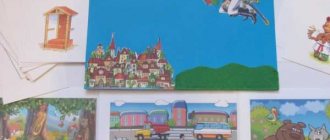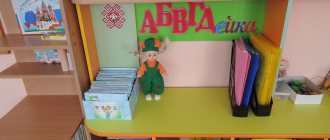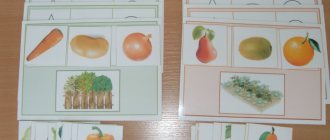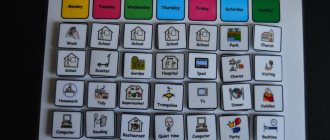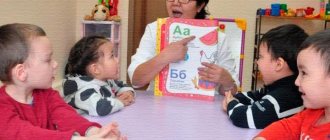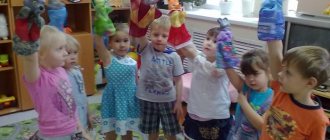What teaching aids can you make yourself for kindergarten?
Language development is not an isolated skill. To a large extent, it is determined by the general level of development of the child and, in particular, his intelligence.
Didactic manual on speech development
Activities that improve sensory and fine motor skills in children are of great importance in this process. For this, it is important to use teaching aids, a significant part of which can be made independently.
Children's learning, especially in junior and middle groups, should take place in a playful environment, otherwise they will lose interest in the subject and time will be wasted. For teaching to be effective, the teacher needs to use all available means to maintain the child’s useful activity.
Didactic materials for sensory development
The “Flower Petals” manual looks like this. A circle is attached perpendicularly to the straight stem. The edges of the central part are covered with Velcro. Several petals with images of objects or fairy-tale characters are offered. This fabric is also attached to the inner edge of each of them. The task is to find the petals with the corresponding words based on the letter drawn on the mug and attach them to the central part.
The game “Blow out the insects into the clearing” is designed to develop speech breathing. For this purpose, the “Polyanka” manual is used. It is a low box with high sides. Small cardboards with images of animals are suspended on short threads from the outside. The child must blow them out, but does not have the right to puff out his cheeks.
Important! In this way he is taught how to breathe correctly during a conversation.
The game "Clothespins" is made using the same manual. For this, the kids are given several colored clothespins and asked to build a fence. They place them on the edges, while loudly calling out the color used.
There are two horizontal lines of Velcro glued to the outer wall of the Polyanka manual. Each row contains four cards with images of animals, fairy-tale characters or objects. The child is told that in each row one of the pictures is extra and is asked to remove it. Then he should tell what the remaining images have in common and why.
Lesson with children
Iconic didactic materials
One of these multifunctional aids is “Teremok”. It is a fabric house attached to a flat, solid base. It has a large number of pockets sewn into it, in which various pictures are placed. They can depict objects of the surrounding world, fairy-tale characters from the fairy tale of the same name, images of letters or syllables.
Open lesson on speech development in the second junior group
There are various ways to use this manual in kindergarten.
Here's one of them. Children are shown pictures taken from a pocket attached to the tower. They ask what fairy tale this hero, who is depicted on the card, came from. The child must remember the name of the fairy tale and try to retell its content.
Important! If the child needs the help of a speech therapist, then it is provided. During the story, the teacher asks the child simple leading questions.
You can also use this manual in a preschool educational institution as follows:
- The teacher takes out cards showing the inhabitants of the tower, but does not show them. He depicts the sounds these animals make. The child must repeat them and name the hero of the fairy tale who is depicted on the card.
- The manual can be used to study prepositions that show the relative position of cards. The teacher places cards with pictures of animals in various pockets and asks questions about who is located where. The child must answer using the prepositions “above,” “under,” or “between.”
- Then the child is asked to formulate questions using the mentioned prepositions and ask them to the teacher.
Another task is the following:
- The child is given cards with images of fairy tale characters and asked to place them in various pockets.
- After this, the kid must say which animal lives on which floor and who is to the left, right, above or below him.
Where are teaching materials used?
The use of hand-made speech development aids for preschoolers creates a playful basis for working with them and determines the storyline of the lesson. A child, especially in the junior and middle groups of kindergarten, thinks concretely, using images, rather than abstract logical constructs. He can react to assignments received from a speech therapist or teacher, being a participant in a specific, albeit fictitious, situation. The teaching aids serve as the factual basis for their learning each year.
Speech development based on visual cues
When a child learns to express his thoughts, he must follow a certain pattern of expressing his thoughts. For a child who is almost unable to concentrate on one subject at his age, this is impossible. Using teaching aids in the form of cue cards helps build a story line. For younger children, we are talking about much simpler things. They simply have to name the objects or briefly describe the actions with the cue cards.
Speech therapist works with a child
For example, in the didactic manual “Zippers,” the child must choose among the open colored zippers lying on the table those that correspond to the teacher’s instructions and close them. At the same time, the child describes his choice, its reasons and the actions he takes.
At an older age, each visual cue can be used together with leading questions from the teacher and be the basis for a coherent story. This can be seen, for example, in classes devoted to professions.
Individual speech therapy support programs for children
Every description of your actions, answer to a specific question, or short story based on visual cues helps your child better develop his speech skills. Serve as preparatory exercises for adult life.
Learning to retell
The development of coherent speech in children is one of the most important skills that a child must be taught. Without mastering it, he will not only not be able to develop properly intellectually, but also will not be able to fully socialize, not being able to conduct a dialogue or express his thoughts.
When retelling, the child must create a coherent, long story. However, for this he will need tips, which can be received during didactic games and from the teacher.
The development of fine motor skills plays an important role in this process.
Important! By engaging in retelling, you will be able to strengthen your speech and intellectual skills and increase the level of development of your personality.
Learning to think
Human speech is closely related to thinking. The same is true for a child. Communication is not limited to expressing your thoughts or describing actions. The level of speech proficiency is largely determined by the degree of development of the child’s personality and thinking.
Do-it-yourself teaching aids for kindergarten can be used not only for stories, but also as an excuse to ask your child questions about cause-and-effect relationships in the world around him. For example, using cards related to the plots of fairy tales, you can ask questions about the circumstances of the characters’ actions, the reasons and consequences of their actions.
You can combine the classes in question with the study of mathematics.
In addition, the educational function of speech development classes is important. For example, if a child is asked questions about the features and beneficial properties of the plants depicted in the pictures, then gradually this knowledge will be consolidated in the child. If additional questions are asked about this material, the child’s knowledge will become more detailed and practical.
Preparing for literacy
To do this, you need to learn not only oral speech, but also study letters and words. Children of senior preschool age, with the help of a teacher and parents, are able to master the alphabet and basic reading skills.
For this purpose, a do-it-yourself didactic manual on speech development for kindergarten with cards depicting letters, syllables or words can be used.
Picture 4 Speech corner
“About guys and animals.” Suzanna Bialkowska.
The book is an album for looking at and telling stories with children. The album contains wonderful pictures and tasks in pictures for kids. The album is also part of a series of funny pictures for preschoolers.
What you will find in the album for speech classes and conversations with children:
First. Wonderful ideas - pictures for inventing stories, fairy tales, stories with children, that is, for the development of speech and thinking, the imagination of preschoolers. For example, we liked this idea:
An encrypted message was received from the center at night: “Carrots have disappeared from all stores!!!” Our own correspondent has been sent to investigate this detective moment.”
First we read the quatrain. Next, we figure out what happened and why the carrot disappeared:
- We discuss what could have happened, how it all started, what happened and how it ended.
- We tell or write down our story. If several children composed, then we carefully listen to all the options. Dictation goes like this: the child dictates, I write under his dictation. This technique is called the “written speech situation.” Dictation encourages the preschooler to more accurately select words and construct sentences consistently and coherently, and not repeat the same words in the text.
- When we come up with different versions, we read what actually happened - the artist’s version from the book
The forest people are waiting for information. And finally the report comes: There is no reason to worry. It's Bunny's birthday!
The most important thing in such tasks for verbal creativity is not to guess the artist’s intention, but to develop the imagination of children, teach them to see non-standard ways out of unforeseen situations.
Second. A series of humorous pictures for inventing funny stories with children and teaching kids to see cause-and-effect relationships (11 series of pictures). The topics are different, but all very funny and interesting: “How the mouse defeated the crocodile”, “I was impressed”, “We were in a hurry”, “New Year’s adventures of the Christmas tree”, “They didn’t share”, “These are the helpers!”, “How Sasha punished himself” , “Not at a loss”, “Unlucky photographer”, “If you have ingenuity, skis and poles will help” and others.
Third, tasks in pictures to develop children’s imagination, thinking, and attention:
- Is this true or not? (find errors in confusion),
- Picture for making up dialogues (figure out who says what)
- Winter in the forest - find the fable and the truth in the picture
- Lots of pictures with errors to develop attention,
- Children's poems in pictures.
The album contains wonderful illustrations by children's artist S.K. Bialkovskaya is an illustrator of children's books, postcards, and cartoons, very bright, kind, cheerful and giving joy to both children and adults.
The importance of didactic material in kindergarten
Didactic manuals serve as the basis for speech development classes. They create a storyline for the lesson, involving children in the game plot. This takes into account the concreteness and figurativeness of children's thinking. With their help, a fascinating game situation is created for the child to learn, where he is passionate and motivated to complete tasks.
The development of children's speech relies heavily on various didactic aids. Their diversity and the ability to make most of them with your own hands allows you to choose a suitable option for conducting classes with children.
If I can, I will help. Funny pictures.
The book is also a collection based on materials from “Funny Pictures.” But it's built differently. It contains 29 sheets of picture stories for viewing and making up fairy tales and funny stories. Wonderful drawings and very original stories: “The Greedy Bear”, “The Adventures of Vasya Kalendarkin and his smart puppy Ursik”, “How I started skating”, “The cat loves the fish, but I don’t want to get into the water”, “How the bunny helped Carry a Carrot”, “The Dressmaker” and others.
It's very interesting to tell stories using pictures like this!

